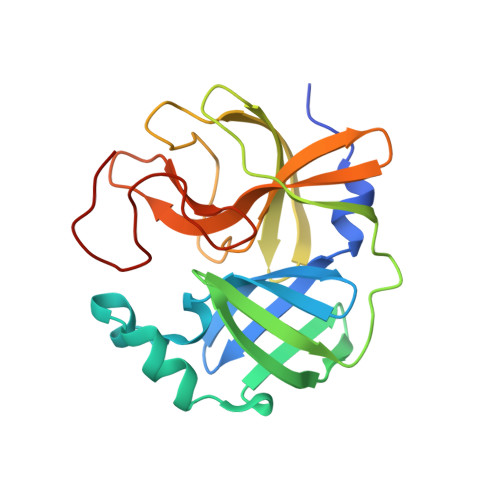Autoprocessing and oxyanion loop reorganization upon GC373 and nirmatrelvir binding of monomeric SARS-CoV-2 main protease catalytic domain.
Nashed, N.T., Kneller, D.W., Coates, L., Ghirlando, R., Aniana, A., Kovalevsky, A., Louis, J.M.(2022) Commun Biol 5: 976-976
- PubMed: 36114420
- DOI: https://doi.org/10.1038/s42003-022-03910-y
- Primary Citation of Related Structures:
7UJ9, 7UJG, 7UJU, 7UKK - PubMed Abstract:
The monomeric catalytic domain (residues 1-199) of SARS-CoV-2 main protease (MPro 1-199 ) fused to 25 amino acids of its flanking nsp4 region mediates its autoprocessing at the nsp4-MPro 1-199 junction. We report the catalytic activity and the dissociation constants of MPro 1-199 and its analogs with the covalent inhibitors GC373 and nirmatrelvir (NMV), and the estimated monomer-dimer equilibrium constants of these complexes. Mass spectrometry indicates the presence of the accumulated adduct of NMV bound to MPro WT and MPro 1-199 and not of GC373. A room temperature crystal structure reveals a native-like fold of the catalytic domain with an unwound oxyanion loop (E state). In contrast, the structure of a covalent complex of the catalytic domain-GC373 or NMV shows an oxyanion loop conformation (E* state) resembling the full-length mature dimer. These results suggest that the E-E* equilibrium modulates autoprocessing of the main protease when converting from a monomeric polyprotein precursor to the mature dimer.
- Laboratory of Chemical Physics, National Institute of Diabetes and Digestive and Kidney Diseases, National Institutes of Health, DHHS, Bethesda, MD, 20892-0520, USA.
Organizational Affiliation:

















